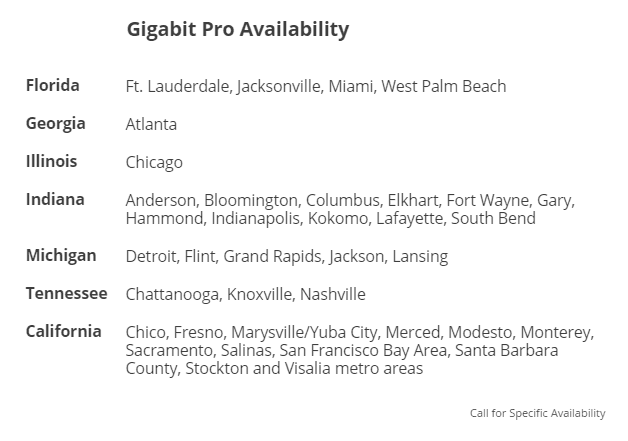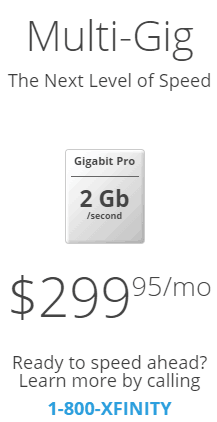 Signing up for Comcast’s 2Gbps fiber to the home service will not come cheap.
Signing up for Comcast’s 2Gbps fiber to the home service will not come cheap.
The cable company this morning announced pricing for its 2,000/2,000Mbps residential-only broadband tier: $299.95/mo with $1,000 in installation fees on the first bill.
If you can afford that, you may not mind Comcast’s other installation and contract requirements:
- The first bill will require a payment of about $1,159 — $500 for installation, $500 for activation plus $159 if you qualify for a limited time service promotional discount;
- Only a select number of residential Comcast customers will qualify for the service — those living within 1/3rd of a mile of Comcast’s existing fiber network in a limited number of cities;
- Customers must opt for professional installation and it may take six to eight weeks to complete;
- A two-year term contract is also required, with a stiff early termination fee;
- Equipment, taxes and fees and other applicable charges extra;
- This tier is exempt from usage caps/usage-based billing, but actual speeds vary and are not guaranteed.

 Later this year, the service is also expected to reach further west:
Later this year, the service is also expected to reach further west:
- Colorado: Denver, Fort Collins, Loveland, Longmont and Colorado Springs
- Minnesota: Minneapolis/St. Paul
- Oregon: Portland
- Texas: Houston
- Utah: Salt Lake City
- Washington: Seattle, Spokane, Tacoma, and Everett


 Subscribe
Subscribe
Bahahahaha! Good luck with that.
Central Illinois continues to get dissed by Comcast! I understand why Comcast would start with the Chicago area in Illinois.
BUT, don’t understand why Comcast is so in love with smaller cities in Indiana and Michigan, but don’t give a hoot about similar smaller metros in Central Illinois!
My guess is the hardware in the area is probably more up to date. Your cable company may have been acquired from someone else a decade or so ago and Comcast has been relying on what it got.
You have Comcast, we have Frontier. It’s the same story.
I acknowledge that you could be right. But, Insight/Comcast had a 50/50 partnership in these Indiana/Central Illinois areas for a few years. Insight ran it, while Comcast seemed to be more of a silent partner. Eventually, they agreed to split systems between themselves. Comcast got Indiana/Central Illinois and Insight got Ohio, southern Indiana, Kentucky.My point is that Comcast would/should have known the details of these acquired systems.
Both some of the Indiana(Bloomington, Anderson, and Lafayette/Kokomo) and Northern(non Chicago)/Central Illinois Comcast properties(Rockford/Dixon, Quincy/Macomb, Springfield, Peoria, Champaign-Urbana, Bloomington-Normal) were acquired by Comcast from Insight at the same time, back in 2007/2008.
I could understand maybe $100-$120/Month with a $500 installation fee but this is just price gouging at it’s finest. This just shows their level of greed.
I call it the “go away” price. I first thought this pricing would be attractive to business customers, but then I see it is residential-only. The $1,000 fee is a built in disincentive that allows them to issue reams of press releases touting their speeds without having a high demand from customers requiring them to spend money to actually extend the fiber to them. In other words, more fiber to the press releases.
I’d assume they want you to buy the fiber, run it from the curb to your house and then pay them their “fees” to get started and the monthly price is probably promo anyways so it would be very interesting to see what it will be after the first year. And by going with their “up to” phrasing on most of these providers you may not even get the quoted speeds.
This looks to me like what I have predicted all along. They are pricing their fast and no cap service at a level where they are getting the same amount of money from those who cancel their cable as they would had they stayed with cable and a lower tier internet service (with caps). I’ve said the same thing about menu selection of channels. If it were to ever come about, the cable companies will find a way to price the individual channels so that the price of any chosen 20 or 30 stations equals that of the full cable… Read more »